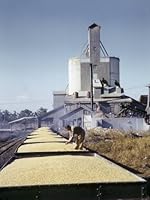 As most dryland corn producers know, the only defense against mycotoxin contamination in corn is to manage the grain moisture content and grain temperature to minimize mold growth in the grain. Recommendations to protect stored grain:
As most dryland corn producers know, the only defense against mycotoxin contamination in corn is to manage the grain moisture content and grain temperature to minimize mold growth in the grain. Recommendations to protect stored grain:Dry dryland corn down to 13% moisture if it’s to be stored for more than a month.
Run aeration fans whenever the air temperature was 10 degrees cooler than the grain temperature since the rate of mold growth is slower at cooler temperatures.
Cool stored grain down to 30°F (plus or minus 5 degrees) to stop mold growth. If the grain has not been cooled to the recommended temperature for late fall and winter, do so soon, especially if the grain will be kept into the new year.
 In fall and winter, grain next to the bin wall will be cooled while grain in the center of the bin will stay warmer. The difference in temperature can result in convection air currents migrating through the grain (Figure 1). The warmer air in the center of the bin rises and the grain next to the cold bin wall sinks. When the warm rising air encounters the colder air at the top of the bin, the escaping air can go below the dew point temperature of the rising air and deposit moisture on the grain. This can create a wet spot in the top-center of the bin.
In fall and winter, grain next to the bin wall will be cooled while grain in the center of the bin will stay warmer. The difference in temperature can result in convection air currents migrating through the grain (Figure 1). The warmer air in the center of the bin rises and the grain next to the cold bin wall sinks. When the warm rising air encounters the colder air at the top of the bin, the escaping air can go below the dew point temperature of the rising air and deposit moisture on the grain. This can create a wet spot in the top-center of the bin.If the grain is warm enough for microbial activity, a hot spot can form and molds can grow, even in winter. This includes molds that can produce mycotoxins.
Run the aeration fan(s) at least once a month when the humidity is low and the ambient air temperature is 30 to 35 degrees. To conduct a preliminary check on grain quality, start the aeration fan(s), then climb up and lean into the access hatch. If the air coming out of the hatch is 1) warmer than you expected, 2) has a musty order or 3) If condensation forms on the underside of the bin roof on a cold day, continue to run the fan(s) long enough to push a temperature front completely through the grain.
A rule of thumb is, the time (hours) to push a temperature front through a bin of grain is 15 divided by the airflow-cubic-feet per minute per bushel cfm/bu.
For example, a bin used for drying grain should be able to produce about 1.0 cfm/bu so it would take about 15 hours to push a temperature front through the grain (15/1 = 15). In another example, a bin equipped with a fan able to push only 0.3 cfm/bu could push a temperature front through in 50 hours (15/0.3= 50).
Source: Tom Dorn, Extension Educator, Lancaster County, University of Nebraska–Lincoln
Market Watch
Farm Supply
Farm Magazines
Artwork: Farmers Send Corn Via Rail Cars to a Local Silo for Storage by Howell Walker
No comments:
Post a Comment